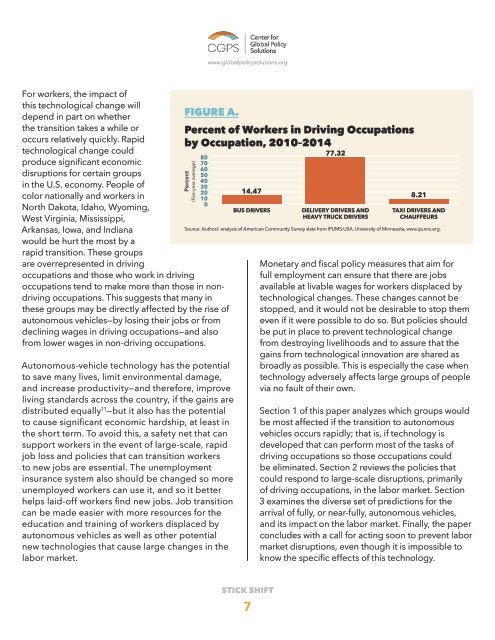STICK SHIFT
Stick-Shift-Autonomous-Vehicles
Stick-Shift-Autonomous-Vehicles
You also want an ePaper? Increase the reach of your titles
YUMPU automatically turns print PDFs into web optimized ePapers that Google loves.
www.globalpolicysolutions.org<br />
For workers, the impact of<br />
this technological change will<br />
depend in part on whether<br />
the transition takes a while or<br />
occurs relatively quickly. Rapid<br />
technological change could<br />
produce significant economic<br />
disruptions for certain groups<br />
in the U.S. economy. People of<br />
color nationally and workers in<br />
North Dakota, Idaho, Wyoming,<br />
West Virginia, Mississippi,<br />
Arkansas, Iowa, and Indiana<br />
would be hurt the most by a<br />
rapid transition. These groups<br />
are overrepresented in driving<br />
FIGURE A.<br />
occupations and those who work in driving<br />
occupations tend to make more than those in nondriving<br />
occupations. This suggests that many in<br />
these groups may be directly affected by the rise of<br />
autonomous vehicles—by losing their jobs or from<br />
declining wages in driving occupations—and also<br />
from lower wages in non-driving occupations.<br />
Autonomous-vehicle technology has the potential<br />
to save many lives, limit environmental damage,<br />
and increase productivity—and therefore, improve<br />
living standards across the country, if the gains are<br />
distributed equally 11 —but it also has the potential<br />
to cause significant economic hardship, at least in<br />
the short term. To avoid this, a safety net that can<br />
support workers in the event of large-scale, rapid<br />
job loss and policies that can transition workers<br />
to new jobs are essential. The unemployment<br />
insurance system also should be changed so more<br />
unemployed workers can use it, and so it better<br />
helps laid-off workers find new jobs. Job transition<br />
can be made easier with more resources for the<br />
education and training of workers displaced by<br />
autonomous vehicles as well as other potential<br />
new technologies that cause large changes in the<br />
labor market.<br />
Percent of Workers in Driving Occupations<br />
by Occupation, 2010–2014<br />
Percent<br />
(five-year average)<br />
80<br />
70<br />
60<br />
50<br />
40<br />
30<br />
20<br />
10<br />
0<br />
14.47<br />
BUS DRIVERS<br />
77.32<br />
DELIVERY DRIVERS AND<br />
HEAVY TRUCK DRIVERS<br />
8.21<br />
TAXI DRIVERS AND<br />
CHAUFFEURS<br />
Source: Authors’ analysis of American Community Survey data from IPUMS-USA, University of Minnesota, www.ipums.org.<br />
Monetary and fiscal policy measures that aim for<br />
full employment can ensure that there are jobs<br />
available at livable wages for workers displaced by<br />
technological changes. These changes cannot be<br />
stopped, and it would not be desirable to stop them<br />
even if it were possible to do so. But policies should<br />
be put in place to prevent technological change<br />
from destroying livelihoods and to assure that the<br />
gains from technological innovation are shared as<br />
broadly as possible. This is especially the case when<br />
technology adversely affects large groups of people<br />
via no fault of their own.<br />
Section 1 of this paper analyzes which groups would<br />
be most affected if the transition to autonomous<br />
vehicles occurs rapidly; that is, if technology is<br />
developed that can perform most of the tasks of<br />
driving occupations so those occupations could<br />
be eliminated. Section 2 reviews the policies that<br />
could respond to large-scale disruptions, primarily<br />
of driving occupations, in the labor market. Section<br />
3 examines the diverse set of predictions for the<br />
arrival of fully, or near-fully, autonomous vehicles,<br />
and its impact on the labor market. Finally, the paper<br />
concludes with a call for acting soon to prevent labor<br />
market disruptions, even though it is impossible to<br />
know the specific effects of this technology.<br />
<strong>STICK</strong> <strong>SHIFT</strong><br />
7


